Biology > QUESTIONS & ANSWERS > BIOD 171 FINAL EXAM STUDY GUIDE (All)
BIOD 171 FINAL EXAM STUDY GUIDE
Document Content and Description Below
BIOD 171 FINAL EXAM STUDY GUIDE Microbiology is the study of what? Correct answer- Microbiology is the study of microbes (microorganisms and viruses) and their biological processes. What i... s the smallest biological unit of life Correct answer- cell What is a macromolecule? Correct answer- A macromolecule is classified as a complex molecule that is composed from smaller subunits. What are the four main types of macromolecules? Correct answer- Proteins, nucleic acids, lipids and carbohydrates What various functions do proteins have in a cell Correct answer- Proteins may facilitate the movement of materials in or out of a cell. Some can act as enzymes that catalyze, or speed up, biochemical processes. Others play a structural role while other proteins, such as filaments, enable movement. What are the two major types of nucleic acids and their roles? Correct answer- There are two major types of nucleic acids: DNA (deoxyribonucleic acid) and RNA (ribonucleic acid). Nucleic acids are chemical molecules that carry genetic information within the cell. DNA contains a vast amount of hereditary information and is responsible for the inheritable characteristics of living organisms. RNA is responsible for deciphering the hereditary information in DNA and using it to synthesize proteins. What is the plasma membrane, and what is it made up of? Correct answer- The plasma membrane serves the cell as a surrounding barrier that separates the inside of the cell from the outside surrounding environment. The plasma membrane also restricts the movement of materials (water, nutrients, etc) either in or out of the cell, thus allowing a cells to absorb and keep what is needed (influx) while also preventing the escape (out flux) of essential nutrients. The plasma membrane is composed of lipids (hydrophobic hydrocarbons). What are the three main components of carbohydrates? Correct answer- Carbohydrates are composed of carbon, hydrogen and oxygen atoms. Examples would include, C6H12O6 (glucose) C12H22O11 (sucrose) and C6H10O5 (cellulose). What is the primary difference between prokaryotic and eukaryotic cells? Correct answer- Eukaryotic cells contain a nucleus, a membrane enclosed region within the cell that contains the genetic material. Prokaryotic cells do not have a nucleus and can be further classified as either Bacteria or Archaea. What are the main morphologies of bacteria? Correct answer- Bacteria can be described as coccus (round/spherical), bacillus (rod), vibrio (curved rod) or spirillum (spiral/corkscrew). Which group (classification) of microbes is noted for its ability to survive under harsh conditions? Correct answer- Archaea. They are able to survive in extremely harsh environmental conditions such as high salt levels, acid conditions, high temperatures and oxygen-poor conditions. What are the four main classifications of Eukarya? Correct answer- Eukaryotic microorganisms are classified as either belonging to Animalia, Plantae, Fungi or Protista. Can viruses be classified as either prokaryotic or eukaryotic? Correct answer- No. Viruses are considered neither prokaryotic nor eukaryotic. Viruses are not considered living and do not replicate on their own, meaning they must replicate within a host. The lipid bilayer of the plasma membrane is composed of what? Correct answer- The cell membrane is a bilayer composed primarily of amphipathic phospholipids, meaning they contain a polar hydrophilic (water loving) head group and a non-polar hydrophobic (water fearing) tail region. The lipid bilayer is situated in such a way where the non-polar tail groups face inward thus orienting the polar head groups to interact with water both outside and inside of the cell. What are the primary cellular organelles described in this module? Be sure to know the roles of each. Correct answer- Ribosomes (protein synthesis), ER (site of protein synthesis), Golgi (protein modification and distribution), lysosomes (waste disposal), mitochondria (ATP generation) and chloroplasts (plants only; site of photosynthesis). What is cellular metabolism? Correct answer- Metabolism is a controlled set of biochemical reactions that occur in living organisms in order to maintain life. What is the primary function of enzymes, and how are they regulated? Correct answer- Enzymes speed up chemical reactions. Most notably, the enzyme is not consumed during the reaction and can be used repeatedly by the cell. Enzymes can also be regulated by a cofactor such that in the absence of the proper cofactor, enzymes are inactive while in its presence enzymes are active. What is the difference between catabolism and anabolism? Correct answer- Catabolism is the process of breaking down larger molecules into useful energy sources whereas anabolism is the building up or biosynthesis of macromolecules from smaller molecular units into larger complexes, most often associated with cellular growth and repair. ATP has the energy to ,BLANK while ADP has the capacity to BLANK energy. Correct answer- donate; accept Chemotrophs can be subdivided into what two additional subgroups? Correct answer- Chemotrophs, which acquire energy from preformed chemicals found in the environment, can be divided into either organotrophs (removing electrons from organic molecules such as glucose) or lithotrophs, which remove electrons from inorganic molecules. Chemotrophs utilize which form of phosphorylation? Correct answer- Chemotrophs use oxidative phosphorylation (as opposed to photo or substrate-level phosphorylation). Oxidative phosphorylation utilizes the energy released by the chemical oxidation of nutrients to reform ATP. What are the three distinct stages in the catabolism of glucose? Correct answer- Glycolysis is the first step of this process and yields 2 molecules of ATP. Next, by either fermentation (or respiration) 2 additional molecules of ATP can be produced. Last, the electron transport chain (ETC) produces 34 ATP via an oxidative phosphorylation event at the plasma membrane. What are the reactants of glycolysis? Correct answer- Reactants are defined as any molecules present and involved at the beginning of a specific chemical reaction (ie) glycolysis. In terms of writing out a chemical reaction, the reactants are everything located to the left of the arrow. The reactants of glycolysis are glucose, the co-enzyme NAD+ and ATP. What are the two main strategies for replenishing cellular concentrations of NAD+, and when these strategies be utilized? Correct answer- Fermentation and Respiration are the two strategies used by the cell to convert NADH (end product of glycolysis) back to NAD+. Fermentation occurs in the absence of oxygen (anaerobic conditions) while respiration occurs under aerobic (presence of oxygen) conditions. Notably, respiration is more efficient that fermentation. How are the TCA and ETC related? Correct answer- The end products of the Kreb's (TCA) cycle are used to fuel the electron transport chain. In other words, as the Kreb's cycle (TCA) produces an abundance of reduced electron carriers (NADH and FADH2), it fuels the ETC. As the electrons are transferred from NADH/FADH2 to terminal electron acceptors a proton motor force is generated, ATP synthase is activated and up to 34 molecules of ATP can be produced. In the absence of sugars, are entirely different metabolic pathways used to process alternative sugar sources (fructose or lactose)? Correct answer- No. Additional enzymatic steps are simply required at the beginning of catabolism to convert complex sugars into the usable forms of either glucose or a glucose intermediate (glucose-6-phosphate). Proteases are used to catabolize what? Correct answer- Proteases are used to breakdown proteins (whereas lipases are used to breakdown lipids). Excluding sugars, what are the other sources of energy? Which is highest in energy? Correct answer- Polysaccharides, proteins and lipids can all serve as potential energy sources in the absence of sugar. Lipids are rich in energy, often having several reduced carbon molecules (high in hydrogen content) that can be used in both the TCA and ETC cycles. In what organelle does photosynthesis take place? Correct answer- Photosynthesis, the process of capturing sunlight and converting it into usable energy source, occurs in the chloroplasts. Chloroplasts are double-membrane enclosed organelles. Each chloroplast contains the green photosynthetic pigment chlorophyll. In phosphorylation, the light reactions always occur where? Correct answer- The process of converting light energy into chemical energy (photophosphorylation) always occurs in the membrane. Similar to the electron transport chain, one of its main functions is to generate a proton concentration gradient to generate ATP. What are the byproducts of light reactions used for in dark reactions? Correct answer- The ATP and NADPH produced via light reactions are used in dark reactions to convert carbon dioxide and water into organic carbon compounds as well as useful carbohydrates (a process called carbon fixation). Complete the following chemical reaction by placing the appropriate number in the blanks: __CO2 + __ATP + __NADPH + __H20 →C6H12O6 + __ADP + __NADP+ Correct answer- 6, 18, 12, 12, 18, 12 Identify the enzyme associated with the following enzymatic reactions: A-B → B-A Ab + C → A + Cb Correct answer- Isomerases Transferases What determines the specificity of an enzyme? Correct answer- The specificity of an enzyme is heavily influenced by its active site—a unique chemical structure bound only by select target molecules. The structure is influenced by the amino acid composition of the protein as this in turn influences the fold, shape and 'appearance' of the enzyme. The active site (and it's target protein) can be thought of as a lock-and-key relationship. The active site provides a specificity (like a lock) that only specific target proteins can bind—much like how only a specific key will fit into, unlock and 'activate' a lock. Define the measurements micrometer and nanometer. Correct answer- A micrometer (µm) is defined as being one-millionth of a meter and is commonly designated at 10-6 meters. A nanometer (nm) equals 10-9 m or one-billionth of a meter. What are the two critical factors that influence your ability to see an object? Correct answer- Resolution and contrast. Resolution refers to the distance between two objects at which the objects still can be seen as separate. Poor or low resolution means two (or more) objects may appear as one. The contrast is the difference in light absorbance between two objects. Poor contrast gives a high background and makes the visualization of multiple objects difficult. For instance, trying to identify 2 dark colored objects at night (low light = low contrast) versus the same 2 objects in the middle of a sunny afternoon (bright light against 2 dark objects = high contrast). If you wish to increase the amount of light going into a microscope, what part would you adjust? Correct answer- The iris diaphragm controls the amount of light that passes through the sample and into the objective lens. Thus, as you open the iris more light is permitted to pass through to illuminate the sample. As light passes through a microscope, what is the last piece that light passes before reaching your eyes? Correct answer- Once light passes through the sample and the objective lens it is directed through the ocular lens, or eyepiece, directly into your eye. How is the total magnification of an object calculated? Correct answer- Total magnification is calculated by multiplying the power of the objective and the power of the eyepiece. For instance, a 40x objective with a 10x eyepiece would make an object appear (40 x 10) 400 times larger (400x). What is one limitation of fixing your sample? Correct answer- Fixation requires you to irreversibly kill your sample. Thus, determining the motility (cell movement) of a sample is impossible. Fixation also runs the risk of distorting the specimen shape and arrangement. Phase-contrast microscopy provided what benefits to imaging? Correct answer- Phase contrast microscope can provide detailed images of live cells without staining. By using specialized condensers and objectives, a phase contrast microscope amplifies the slight differences between cells and the surrounding medium (background) to make the cells highly distinguishable. What is the distinguishing feature of dark field microscopy? Correct answer- Unlike bright field or phase contrast microscopy where light passes directly through the sample, dark field microscopy reflects light off of the specimen at an angle. The resulting image is an exceptionally dark background and a vibrant specimen. Unlike brightfield microscope, fluorescence microscopes illuminate samples through what spectrum? Correct answer- The energy of the incoming light is in the form of the ultraviolet (UV) spectrum. What is the primary difference between TEM and SEM? Correct answer- During transmission electron microscopy the electron passes through the sample whereas during scanning electron microscopy the electron is reflected off the sample creating a three dimensional 'shell' model of the specimen. Gram staining is based on what basic principle? Correct answer- Gram staining, developed by Hans Christian Gram in 1884, began with the basic observation that different types of bacteria react differently to various dyes. Some bacteria readily take up a specific dye while others do not. What is a key determinant in a bacteria being Gram-positive? Correct answer- Gram-positive bacteria have a thick peptidoglycan layer. The Gram stain exploits this characteristic by using the dye combinations of Crystal violet and Iodine. Crystal violet is retained by the thick peptidoglycan cell wall and forms a stable complex with iodine (upon its addition) effectively trapping the dyes in the cell. The resulting mixture is a purple coloration of the cell. What is the purpose of heat fixing a sample? Correct answer- Heat fixing ensures the samples tightly adhere to the glass slide prior to staining (and washing) procedures. What is the primary purpose of a wet mount? Correct answer- Wet mounts are most often performed to visualize live cells as well as the motility and behavior of an organism. The acid-fast stain is most often used to identify what specific microorganism? Correct answer- Acid-fast stains are used to identify bacterial stains showing a high degree of resistance to decolorization. Mycobacterium tuberculosis is the most common use for an acid-fast stain. What is another name for a liquid growth media, and what are the basic components? Correct answer- Growth media in a liquid form is often referred to as nutrient broth. As the name implies its composition consists primarily of essential 'ingredients' such as a rich source of sugars, amino acids and vitamins. Together, a nutrient broth provides the microbe with a source of carbon/energy, which, in turn, encourages its expansion. What is selective media? Correct answer- Selective media allows for only the growth of certain microbes while restricting the growth of all others. What is differential media? Correct answer- Differential media is used to distinguish between two (or more) related microbes. What are the requirements of a fastidious microbe? Correct answer- A fastidious microbe is an organism with complex growth requirements such that if absent it will not grow. Enriched medias thus contain these specific and essential nutrients required for the growth of a particular subset of microorganisms. What is agar? Correct answer- In its simplest form agar is liquid growth media that has had a hardening agent added to it. Agar is created when a polysaccharide derived from seaweed (algae) extract is added to growth media. Agar is used to create a solid, smooth surface on which microbes can grow. True or False: LB agar is classified as a non-selective, differential media. Correct answer- False LB agar is both a non-selective and non-differential media. LB agar is often used to expand unknown microbial population because it encourages microbial growth due to the presence of universal nutrients (non-differential) and absence of restrictive factors (non-selective). What are the three forms of hemolysis found on blood agar plates? Correct answer- Alpha (green), Beta (clear zones) and Gamma (white/tan). Microbes capable of alpha hemolysis present with greenish-brown color colonies due to the incomplete (partial) lysis of red blood cells. Beta hemolysis is classified as the capacity of a microbe to completely lyse red blood cells. The resulting lysis presents as a distinct zone of clearing around the growing colony. Gamma hemolysis designates the absence or lack of hemolytic activity and the resulting colonies are often white/tan in color growing on the red background color of the unaffected blood agar plate. What is the primary purpose of Columbia CNA agar? Correct answer- As it suppresses the growth of Gram-negative bacteria CNA agar is, therefore, used for isolation of Gram-positive microbes. Name the type of plate derived from BAP that contains lysed red blood cells. Correct answer- Lysed red blood cells (RBCs) are a primary component in the formulation of Chocolate agar. Define the selective and differential abilities of a MacConkey agar plate. Correct answer- MacConkey agar is selective in that only Gram-negative microbes will grow on the agar—Gram-positive microbes simply do not grow. MacConkey agar is also considered a differential media as it distinguishes between microbes capable of fermenting lactose (red colonies) and those that are non-fermenters (white/tan colonies). What colors would you expect to see on an EMB plate containing E. coli? Correct answer- The EMB plate itself is red in color while in the presence of E coli, the growing colonies will take on a distinctive metallic green sheen. Note: You are responsible for knowing the color and general properties (selective vs differential) of all of the agar plates described within this module, with a special emphasis on how a particular agar plate aids in identifying select microbes. What is the name of the process of spreading a bacterial culture onto a petri dish? Correct answer- Plating. Plating microbes can be done using a sterile loop, a sterile swab, or a sterilized wire loop. Each device is simply a means of spreading the bacteria, most commonly in a simple back-and-forth motion, across the plate. What is the primary advantage of plating a bacterial culture as opposed to having it grow in solution? Correct answer- The primary advantage of plating a bacterial sample onto agar is that cells are held in place. Unlike in a nutrient broth where bacterial cells can multiply but are free to move around in solution, bacteria plated onto agar are fixed in such a way as to support the formation and visualization of colonies. What is the purpose of the quadrant streak approach? Correct answer- The purpose of this method is to generate an individual colony so that a single (pure) bacterial sample can be picked from the plate. In a three-phase dilution gradient, which phase most likely contains individual colonies: phase 1 (P1) or phase 3 (P3)? Correct answer- Individual colonies are most likely going to appear within the phase 3 streaks. You begin with P1 (highest concentration), dilute during P2 and then further dilute the sample in P3. However, it is possible to see individual colonies in P2 if only a small portion of P1 was carried over into P2. Define the concept of universal precautions. Correct answer- Universal precautions means any and all samples, whether known or unknown, are to be treated as potentially hazardous (or pathogenic) materials. What would a researcher be certain to note while analyzing a microbial sample? Correct answer- A lab researcher would be certain to note: 1. Size and shape 2. Any observable motility 3. Gram status (positive or negative) 4. The presence of any chemical reactions 5. Changes in color localized to the organism or the surrounding media 6. Capture (or draw) images of any of the characteristics described above Which non-selective yet differential agar plate should be used if a Streptococcus sample is suspected? Correct answer- A BAP (blood agar plate) would be the quickest way to identify and classify a potential streptococcus microbe based on its hemolytic properties. What disease can result if a patient with streptococcal pharyngitis goes untreated? Correct answer- Rheumatic fever occurs in approximately 3% of untreated cases of streptococcal pharyngitis, presenting approximately 2-3 weeks post-infection. Streptococcus, E. coli, pseudomonas, and klebsiella are all capable of causing what disease? Correct answer- All of the above foreign microbes are capable of causing septicemia, also known as blood poisoning. What is a facultative anaerobe? Correct answer- A facultative anaerobe is capable of growth under both aerobic (with oxygen) and anaerobic (in the absence of oxygen) condition. How can Staphylococcus be differentially tested? Correct answer- Staphylococcus species are capable of growth in the presence of bile salts. A bacterial swab is taken from a patient with impetigo and streaked across an MSA plate. Following incubation at 37C, what will be the color of the agar? Correct answer- The causative agent of impetigo is staph aureus, a Gram-positive bacterium capable of fermenting mannitol. Fermentation will lower the pH of the agar and change the dye color from red to yellow. If a patient were suspected to have tuberculosis (TB), which differential stain would you select and why? Correct answer- To stain for TB, one would utilize an acid-fast stain to best visual the foreign microbe. As a mycobacterium tuberculosis would stain poorly (indeterminate) using the Gram stain. According to the module, which mycobacterium infection will be treated free of charge by the World Health Organization (WHO)? Correct answer- Leprosy is completely curable using a multiple-drug therapy regimen consisting of various combinations of the drugs dapsone, rifampin and clofazimine—all of which is given free of charge. What are the three main conditions caused by the botulism toxin? Correct answer- Foodborne, infant and wound. Foodborne botulism is often the result of improperly canned, contaminated, low-acidic foods such as green beans, corn and beats. Infant botulism occurs when children, usually under the age of 6 months consume foods containing the bacteria. A potential source of infant botulism is honey (which is why pediatricians recommend avoiding feeding honey to infants) but can also be found in common places such as soil. Wound botulism occurs when C. botulinum bacteria colonize a deep wound, often a puncture such as those who inject street drugs such as heroine. As contaminated needles are injected through the skin, spores enter the body and, in the absence of oxygen, release the toxin. Why are infants (< 6 months) more susceptible to botulism? Correct answer- Due to infants still maturing intestinal tract and lack of an adult microbiota, the bacteria are able to colonize and produce the associated toxin. In adults, only the direct ingestion of the pre-formed toxin causes disease—ingestion of C. botulinum or the associated spores do not cause illness as a mature intestinal microbiota sufficiently prevents bacterial germination and growth. What is the mechanism of action of the toxin produced by clostridium tentani (tetanus)? Correct answer- The toxin acts on inhibitory neurons causing systemic muscle stiffness and spasms. Muscle stiffness can be observed in the jaw (lock-jaw) or spread systemically (if left untreated) to muscles relating to respiratory function. What Gram-negative bacterium might you come into contact with in a unsanitary hot tub? Correct answer- Legionella is often associated with unclean water systems such as hot tubs, hot water tanks and AC units. Notably, legionella can only be transmitted through water droplets small enough to be inhaled. What are the three forms of plague, and what regions do they affect? Correct answer- Bubonic (lymph), pneumonic (lungs) and septicemic (blood). Bubonic plague is best characterized by painfully swollen lymph nodes. Pneumonic plague affects the respiratory system (lungs). The most rare of all three plagues, septicemic plague targets the blood system and, if left untreated, will develop into a life-threatening illness as the blood-borne bacteria can infect all major organs. According to the module, which STD might be best identified via dark-field microscopy? Correct answer- Syphilis. The causative agent, treponema pallidum, is a thin spirochete, making Gram staining (and visualization) difficult. Treponema is therefore most often best identified via dark-field microscopy. Can viruses be classified as either prokaryotic or eukaryotic microorganisms? Correct answer- No. Viruses are neither prokaryotic nor eukaryotic. What is an obligate intracellular parasite? Correct answer- As an obligate intracellular parasite, viruses cannot (obligate) replicate unless inside (intracellular) a living host cell. As a parasite, a virus depends on its living host to provide the framework (proteins, etc) to replicate—to make additional copies of itself. What is a viral capsid? Correct answer- The capsid is a membrane-like protective structure that contains the genetic material, similar to the nucleus of a eukaryotic cell. What is the viral envelope, and what does the presence (or absence) of it tell you about the type of virus? Correct answer- The envelope surrounds the viral capsid, is derived from the host cell membrane and serves as an additional barrier to the external environment. The overwhelming majority of animal viruses are enveloped whereas the majority of plant or bacteria-infecting viruses are not. What type of microscope would be used to study the shape of a viral capsid? Correct answer- Due to its size (~30-150 nm) most viral capsids must be visualized via electron microscopy. How does the viral envelope both aid in cell entry as well as hide it from being detected by the immune system? Correct answer- The viral envelope contains the necessary proteins required for interaction with host cells. As the envelope is derived from the host cell membrane, this camouflages the virus and lowers the likelihood of immune detection by making it appear similar to the normal biological host cell. What must happen before viral replication of its genome can occur? Correct answer- For all viruses, the genome is replicated following attachment and entry, never before. Describe the basic steps of the viral life cycle. Correct answer- 1. Attachment: Viral receptors bind to host proteins on the surface of the cell. 2. Entry: The virus fuses with the host membrane and enters the cell 3. Uncoating: (where applicable) the viral capsid disassembles 4. Replication: The viral genome provides the 'blueprint' to make copies of itself 5. Exit: New viruses are produced and leave the cell 6. New infection: Newly produced viruses leave the host cell and go on to infect new cells. The process outlined above now restarts. What is a bacteriophage? Correct answer- A bacteriophage is simply a virus (phage) that infects bacteria. What structural aspects make bacteriophages distinct from viruses that infect either animals or plants? Correct answer- Bacteriophages possess an icosahedral capsid head group and a helical tail. Attached to the tail are fibrous extensions or 'legs' that aid in binding host cells. Notably, this particular structural arrangement has not been observed among viruses that infect either animals or plants. Which viral replicative process results in the destruction of the host cell? Correct answer- The lytic replication cycle occurs when a bacteriophage replicates within a host until it ruptures, effectively destroying the host bacterial cell. The phrase lytic stems from 'lysis', meaning to rupture or disintegrate (breakdown) a cell. Describe the appearance of a bacterial culture infected with virus at the time of infection versus later once viral replication is occurring at a high rate. Correct answer- During the initial inoculation of virus and bacteria, the media has a high degree of turbidity (cloudiness). However, as the lytic cycle progresses and more and more bacterial cells are destroyed, the culture media turns from turbid to clear, as turbidity is a function of the number of intact bacterial cells present in the media. Thus, as bacterial cell numbers decrease due to lysis, the media becomes clearer. To what family of viruses does rubella come from and how is it transmitted? Correct answer- Rubella virus belongs to a family of viruses called Togaviridae. Rubella is transmitted via air-borne particles such as when a person coughs. What is the common name for rubeola, and is it a DNA or RNA virus? Correct answer- Rubeola is commonly referred to as the measles and belongs to the family of viruses called Paramyxovirus. Rubeola viruses are RNA viruses with a genome ~ 15,000 nucleotides long. What disease state emerges as a viral reactivation of a prior infection with the varicella virus? Correct answer- Shingles, also known as Herpes zoster, is due to the reactivation of the varicella-zoster virus (VZV). Because VZV lies dormant in inactive nerve cells, its reactivation typically results in painful blisters. However, unlike the initial chickenpox rash, the blisters are localized and limited to small areas. What linear, double-stranded, enveloped DNA virus is the first virus (as of October 26, 1977) to be declared eradicated? Correct answer- Although once a major cause of death in the world, a smallpox vaccine was developed in 1796 by Edward Jenner. Global vaccination efforts have prevented smallpox from appearing in humans since October 26, 1977, making smallpox the first infectious disease ever to be eradicated. What are the two key glycoproteins found in the influenza virus? Correct answer- The viral envelope contains two key glycoproteins, hemagglutinins (HA) and neuraminidase (N). Hemagglutinins are heavily involved in the entry of the viral particle into a host cell, while neuraminidase proteins are involved in the budding and release of new viral particles from the host cell. Describe the composition of HIV. Correct answer- HIV contains two copies of single-stranded, linear RNA that is enclosed by a capsid. The conical capsid surrounds the two RNA strands and is comprised of ~2,000 copies of the viral protein p24. A viral envelope derived from the cell host membrane then surrounds the viral capsid. Within this envelope are two key glycoproteins, gp120 and gp41, which are essential for viral binding and entry into the host cell. [Show More]
Last updated: 1 year ago
Preview 1 out of 13 pages
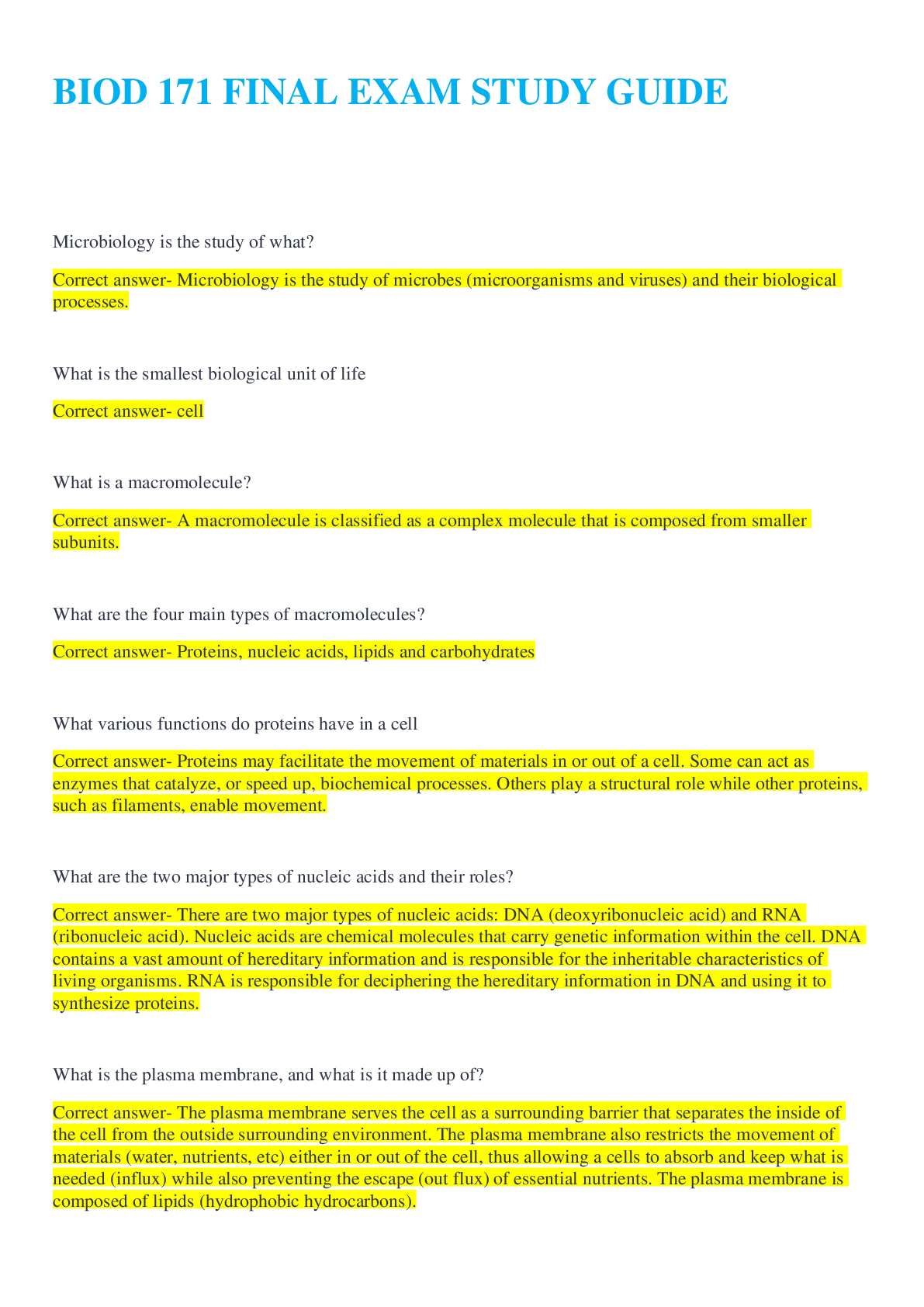
Reviews( 0 )
Document information
Connected school, study & course
About the document
Uploaded On
Jul 30, 2022
Number of pages
13
Written in
Additional information
This document has been written for:
Uploaded
Jul 30, 2022
Downloads
0
Views
44

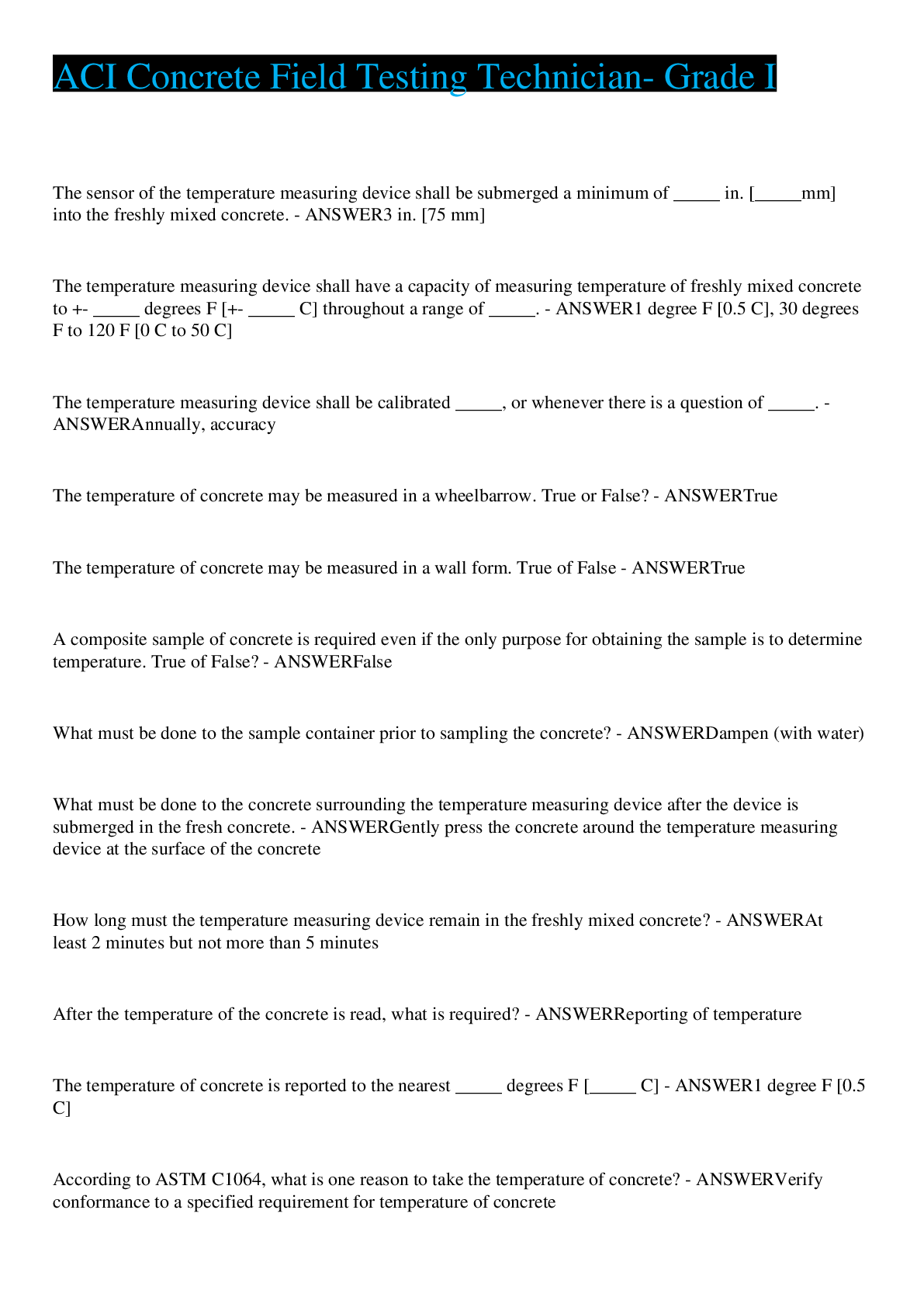


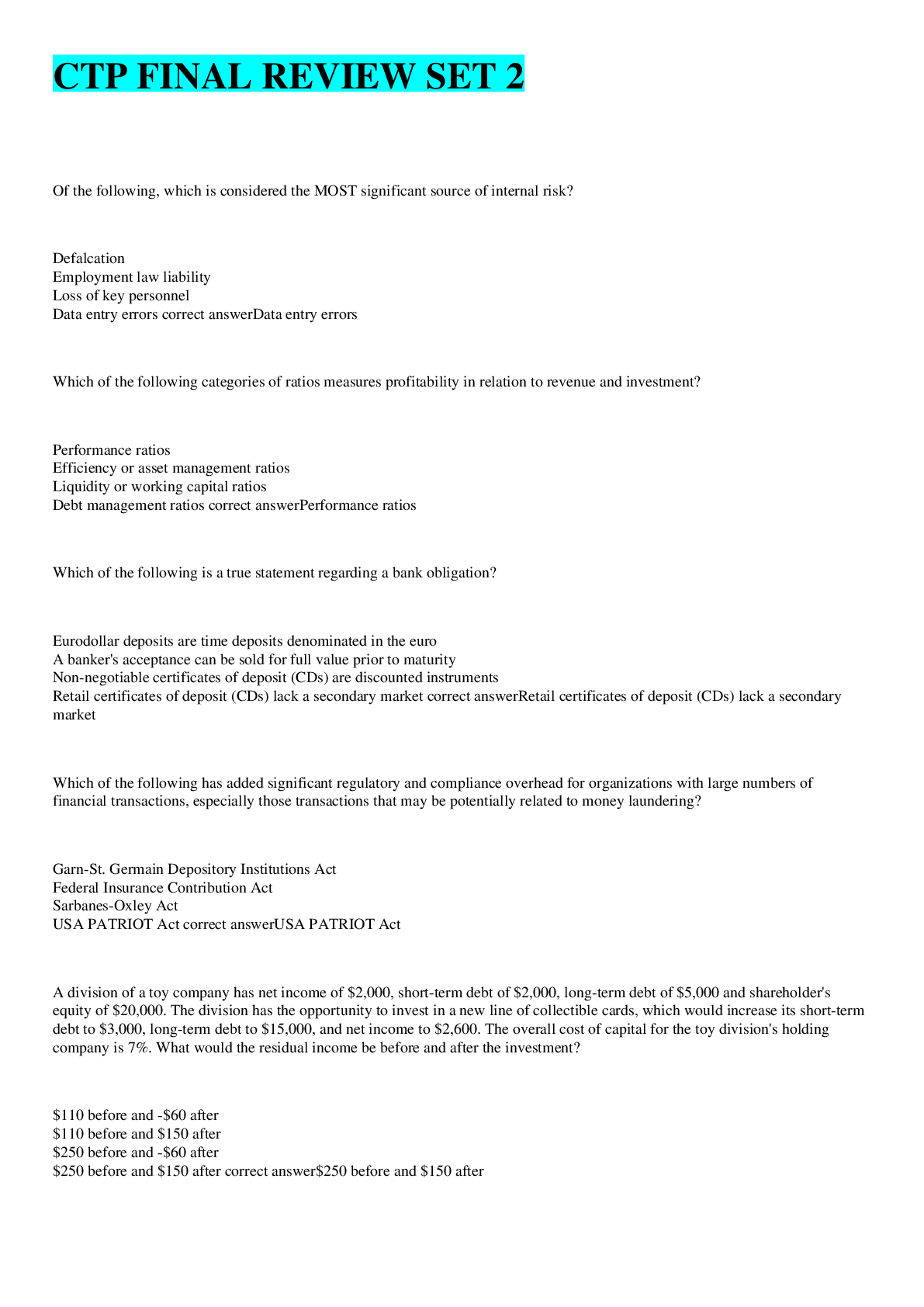
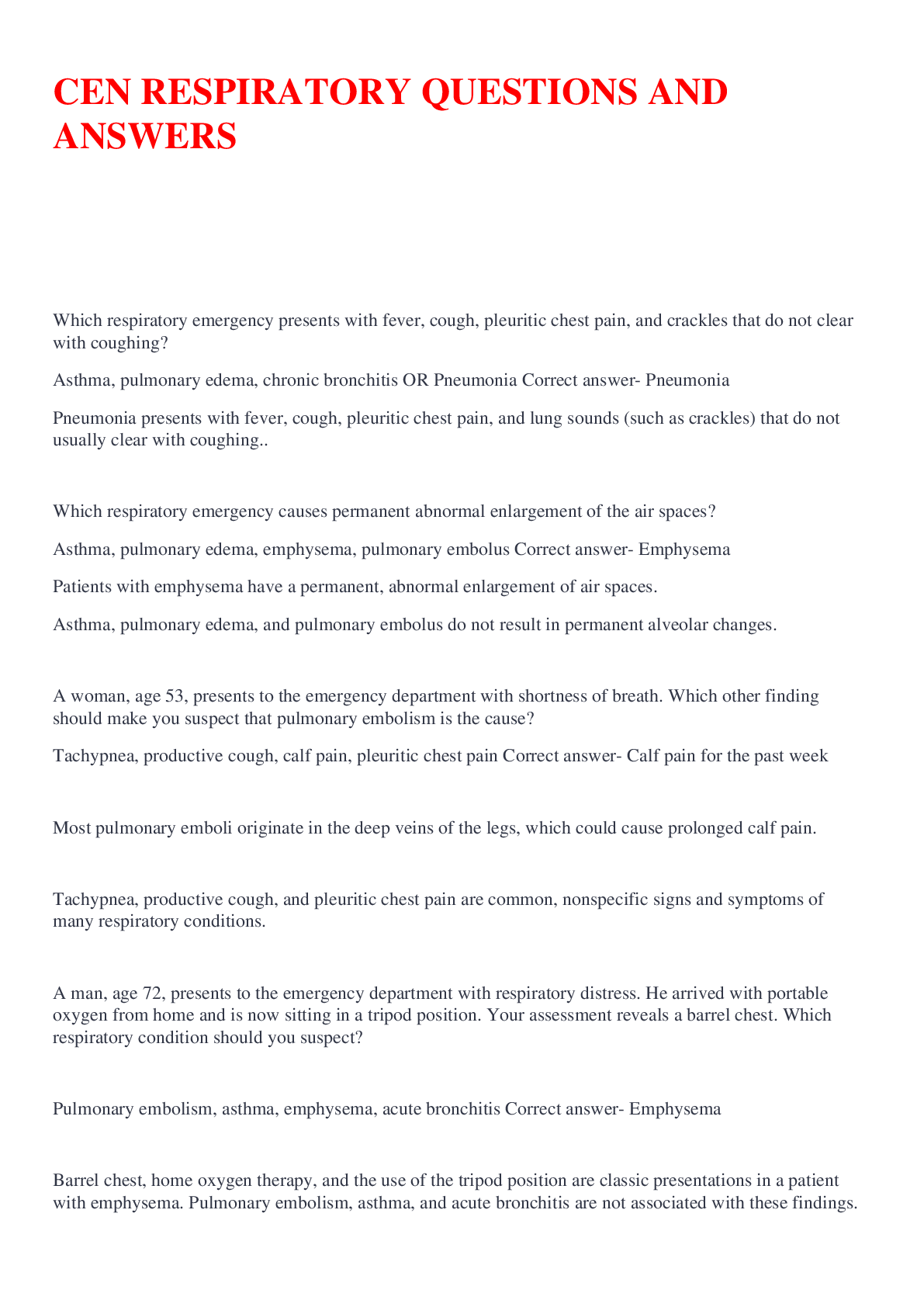
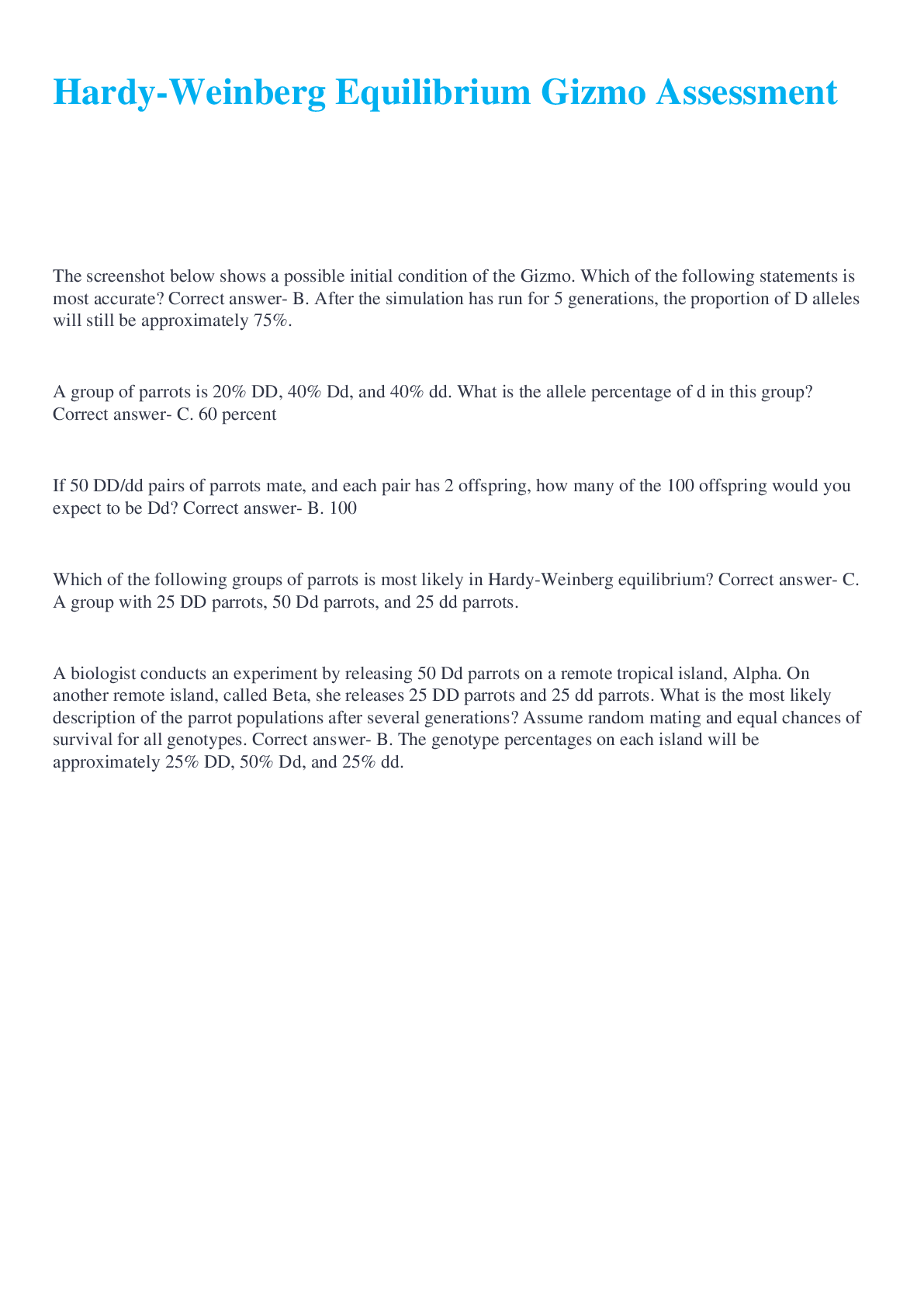
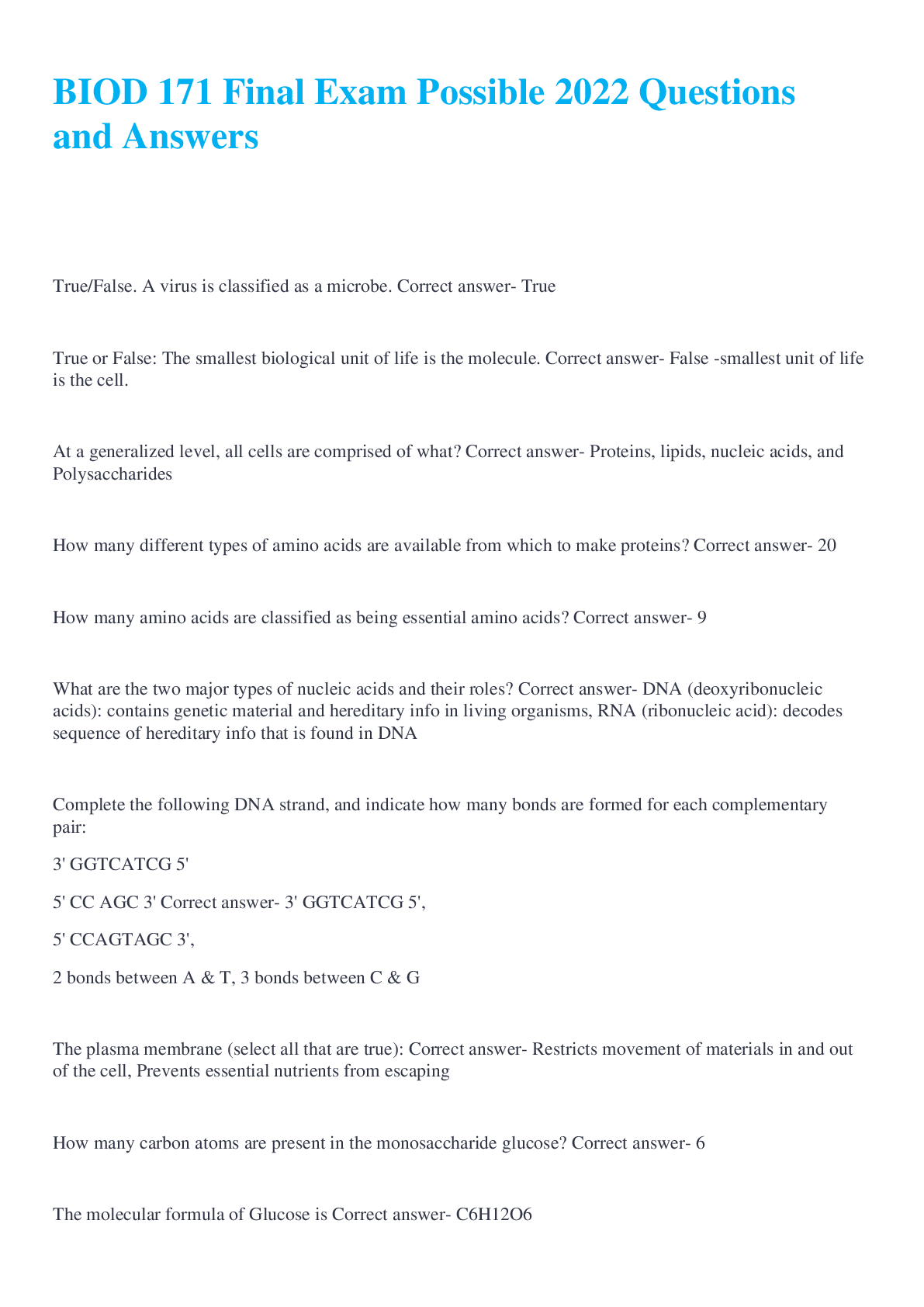
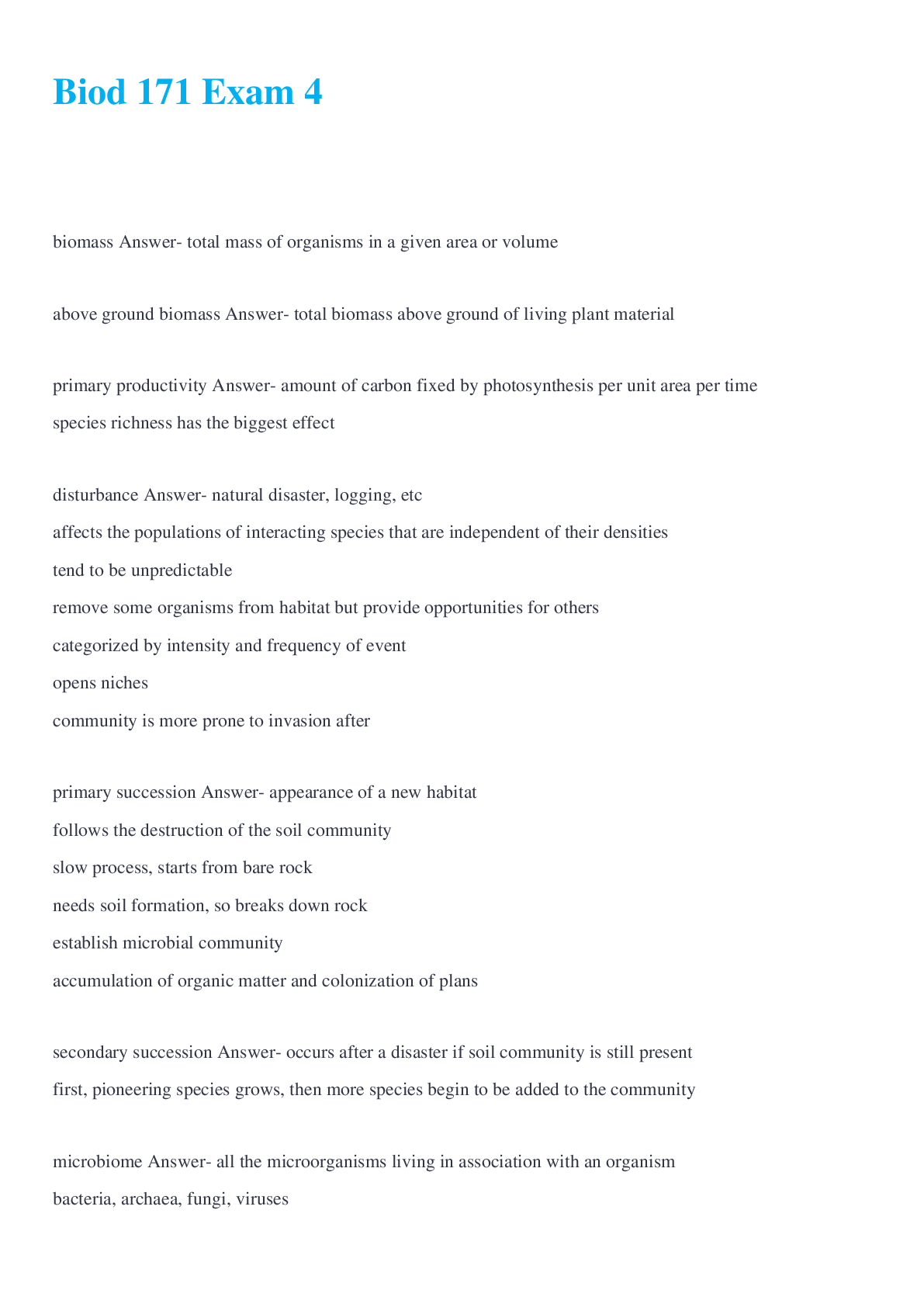
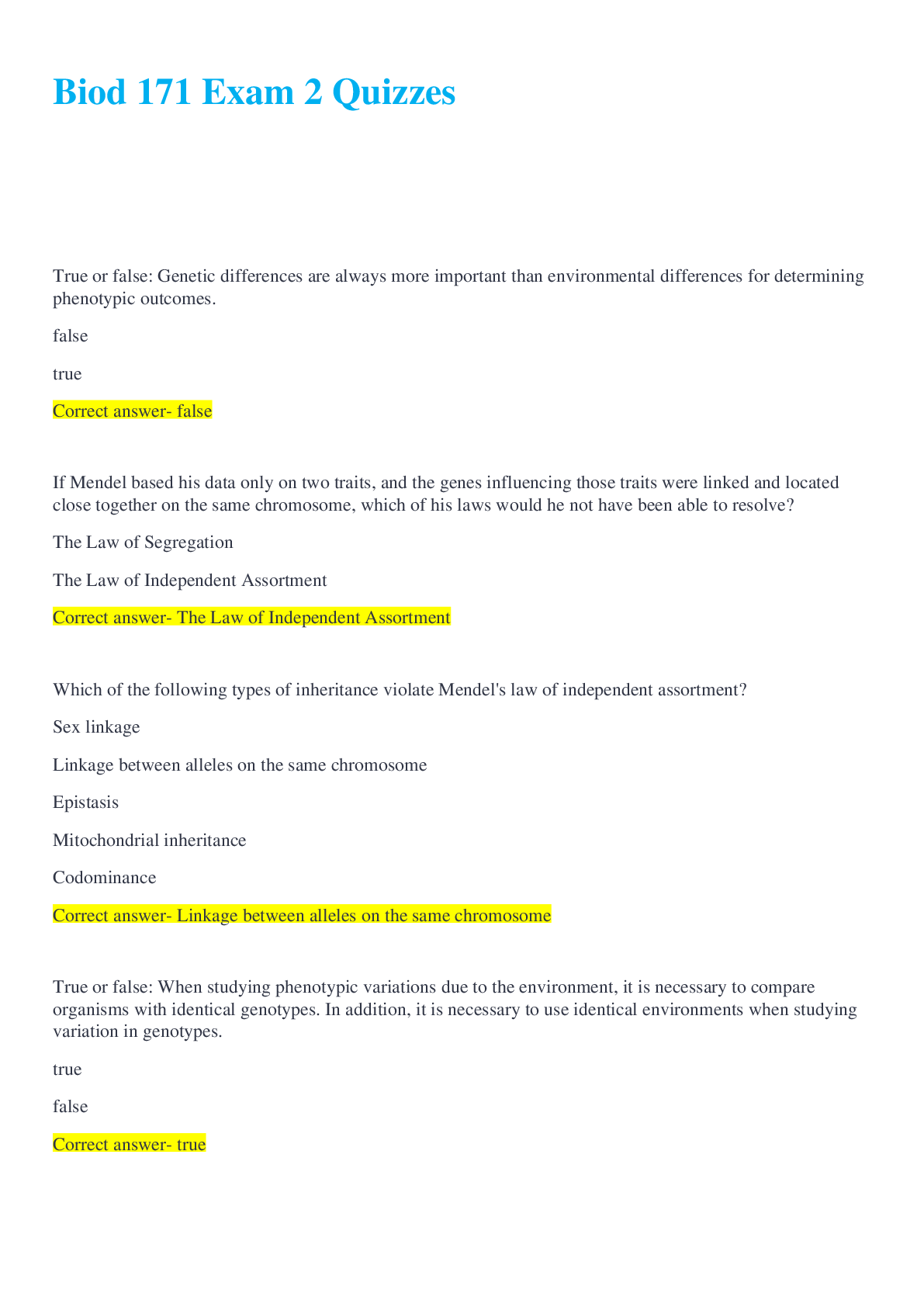

.png)
.png)
.png)

.png)
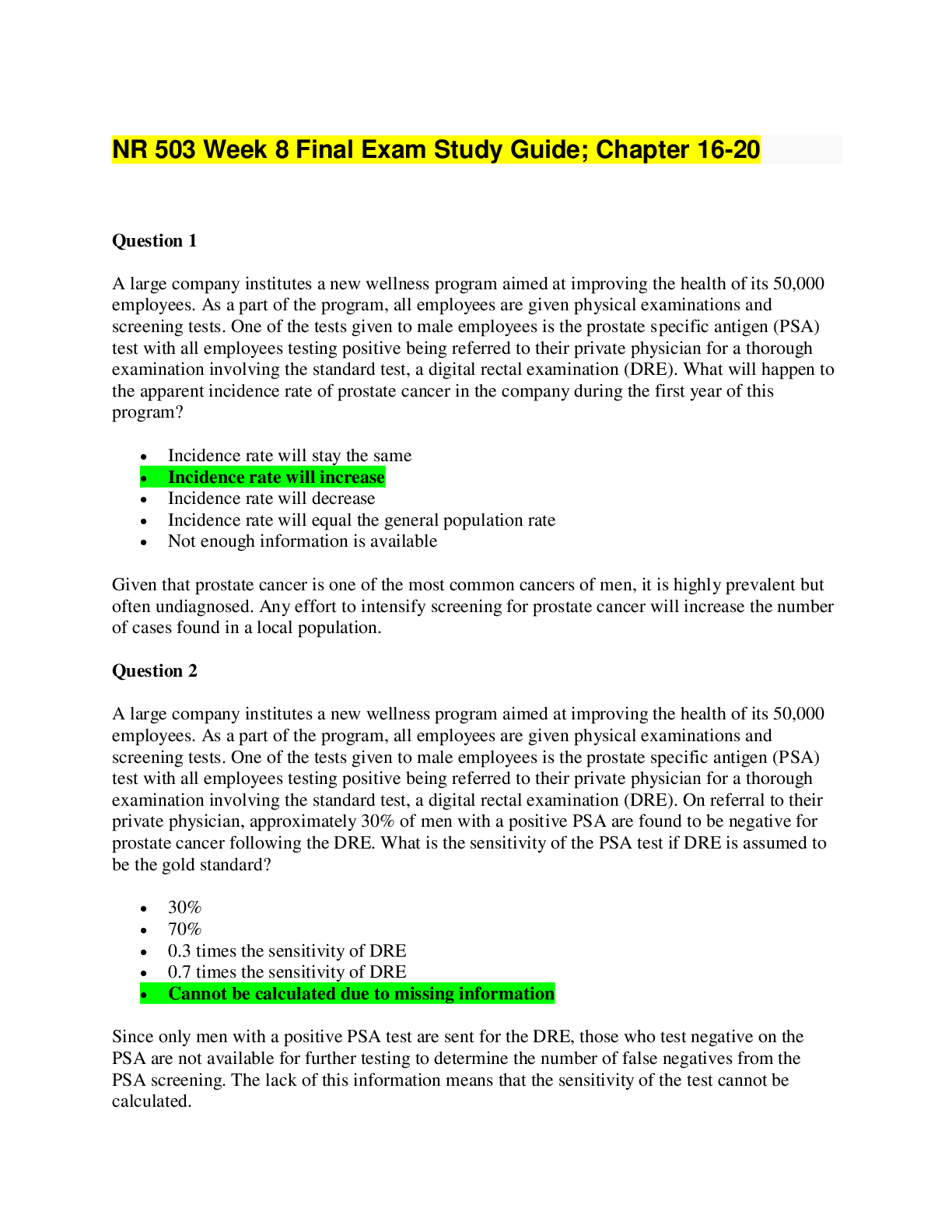



.png)
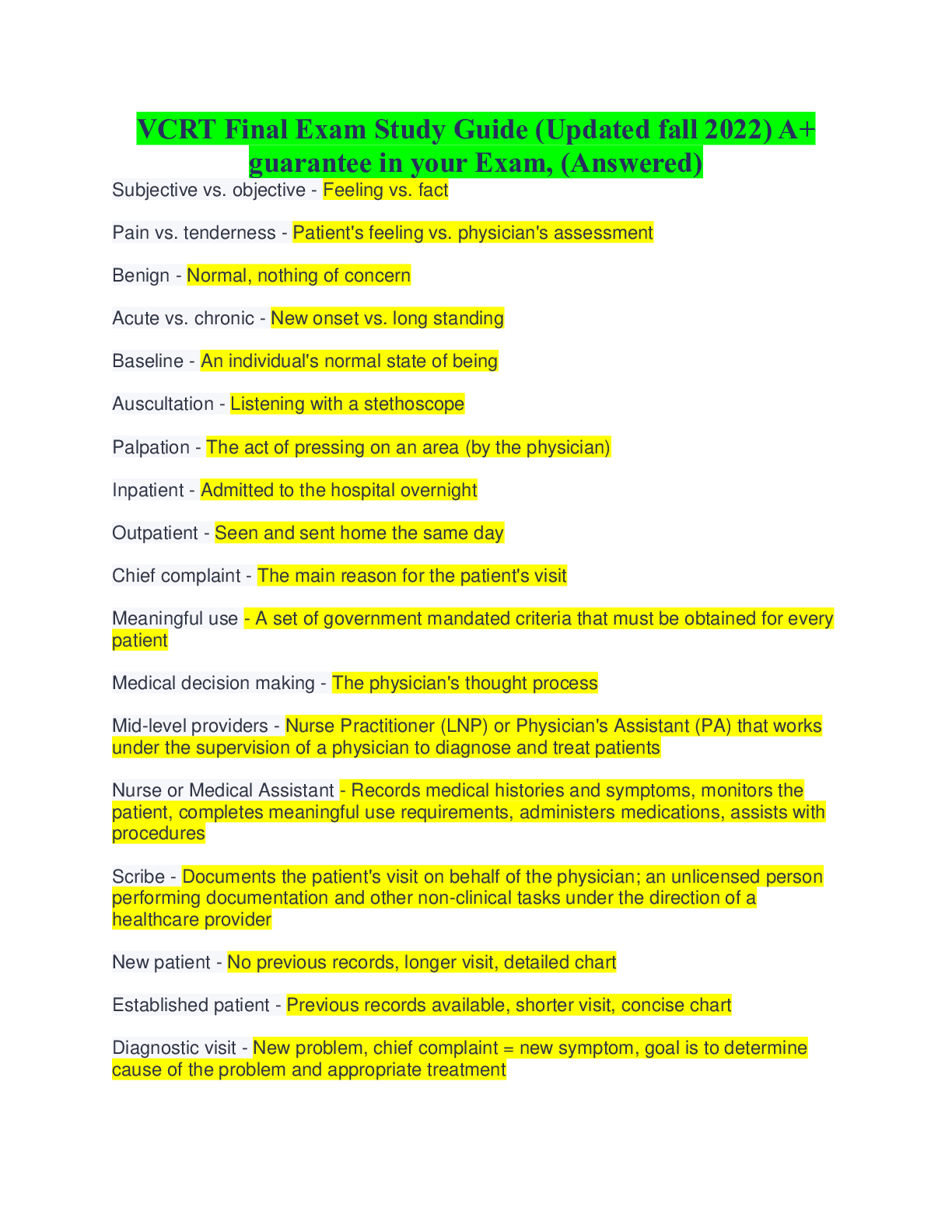
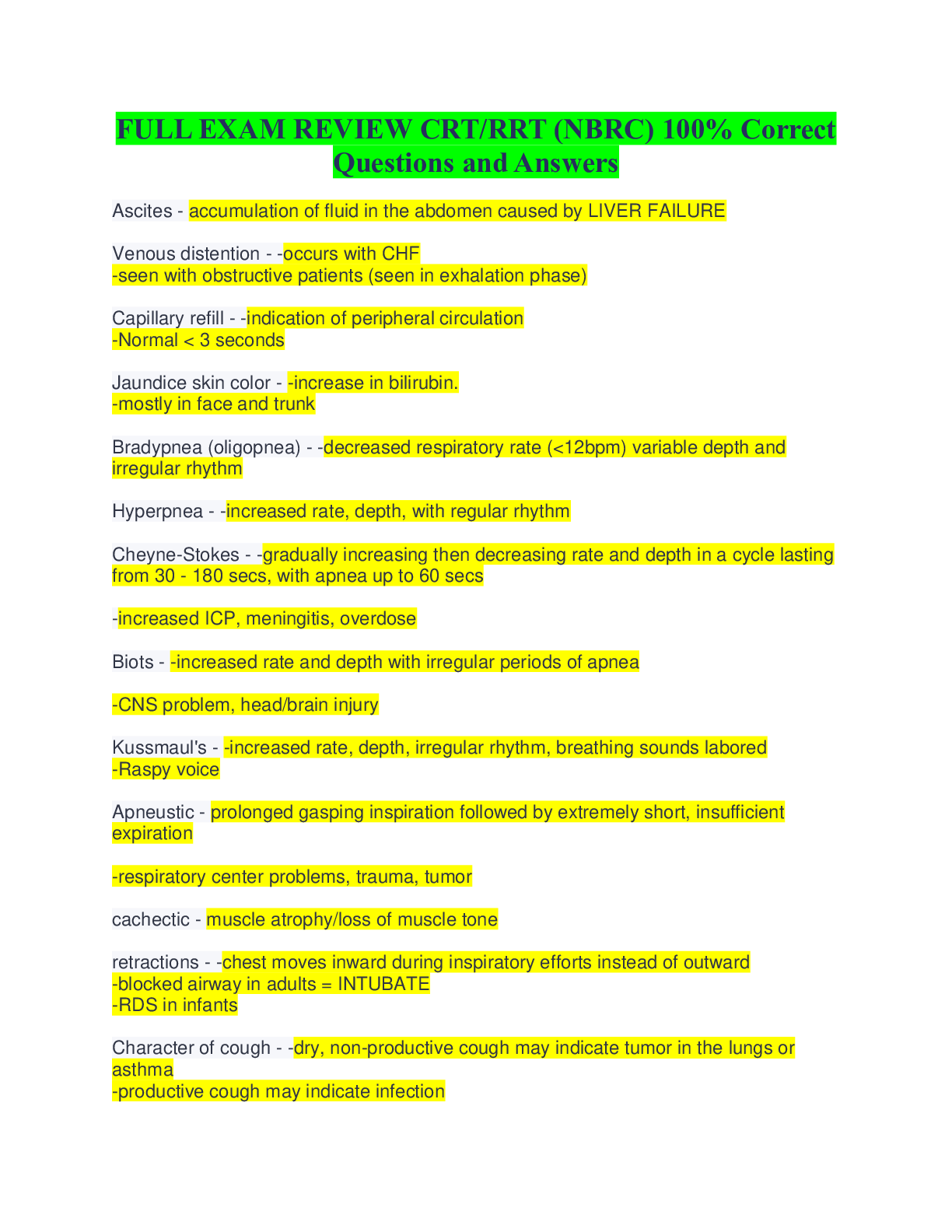
.png)
.png)

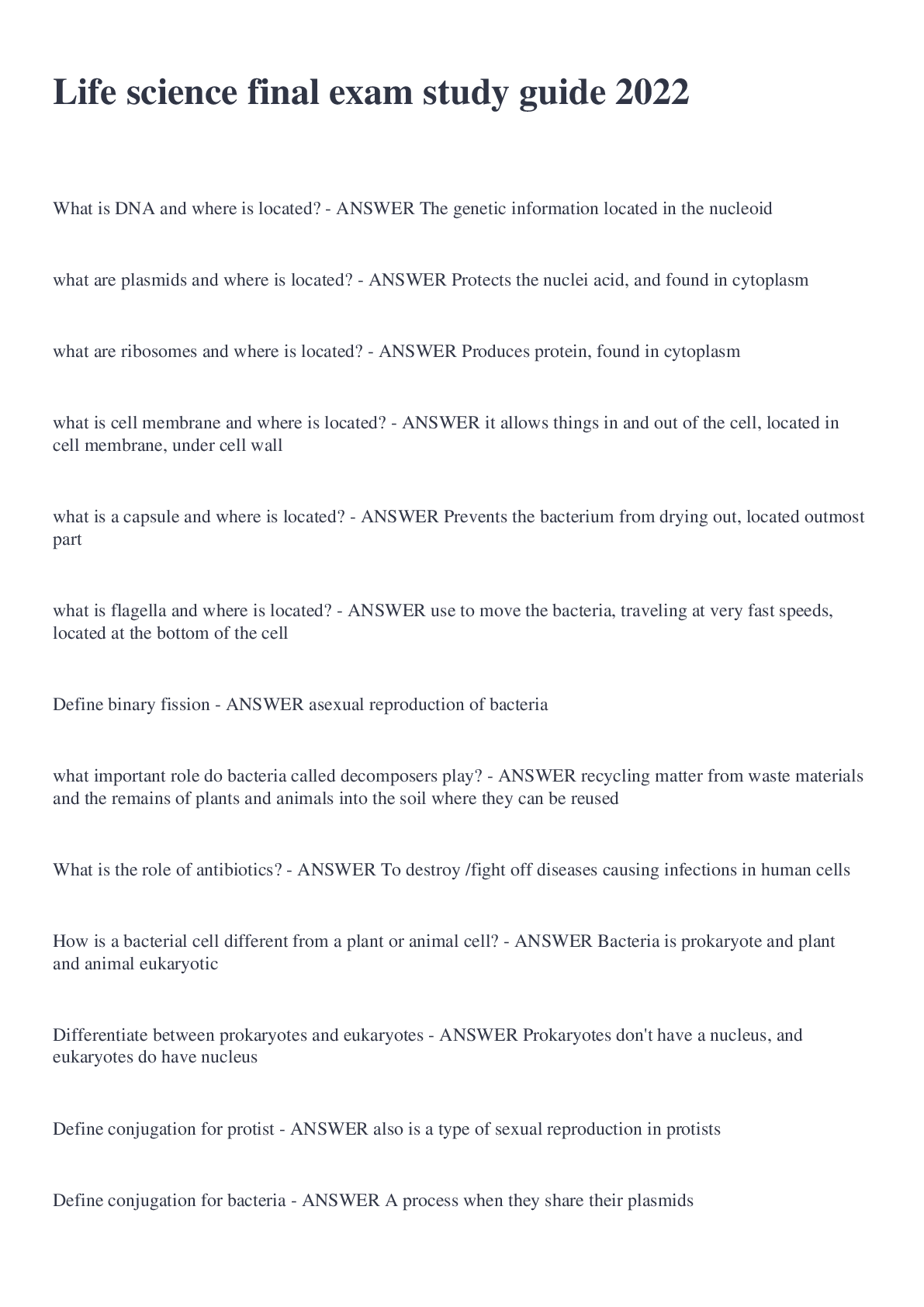



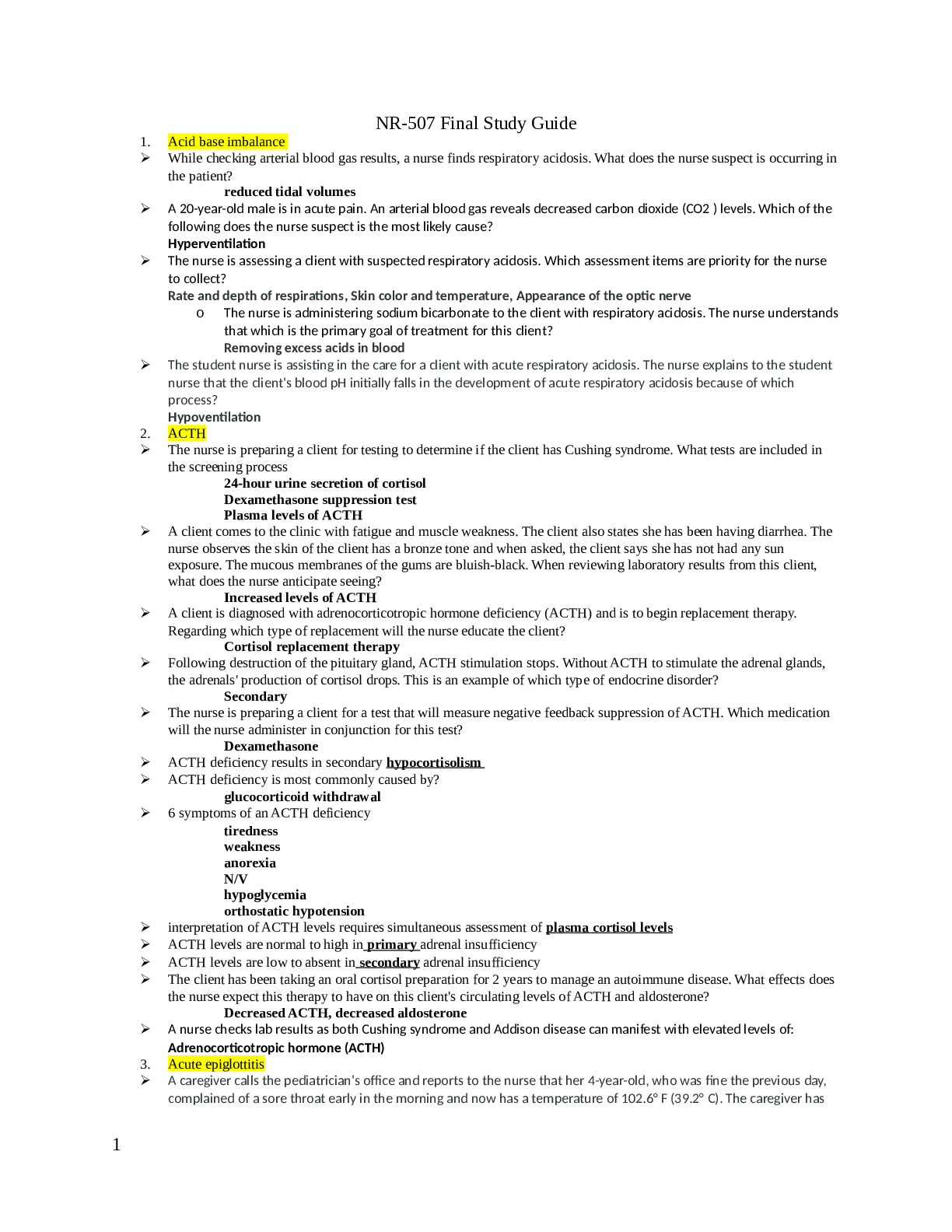
.png)

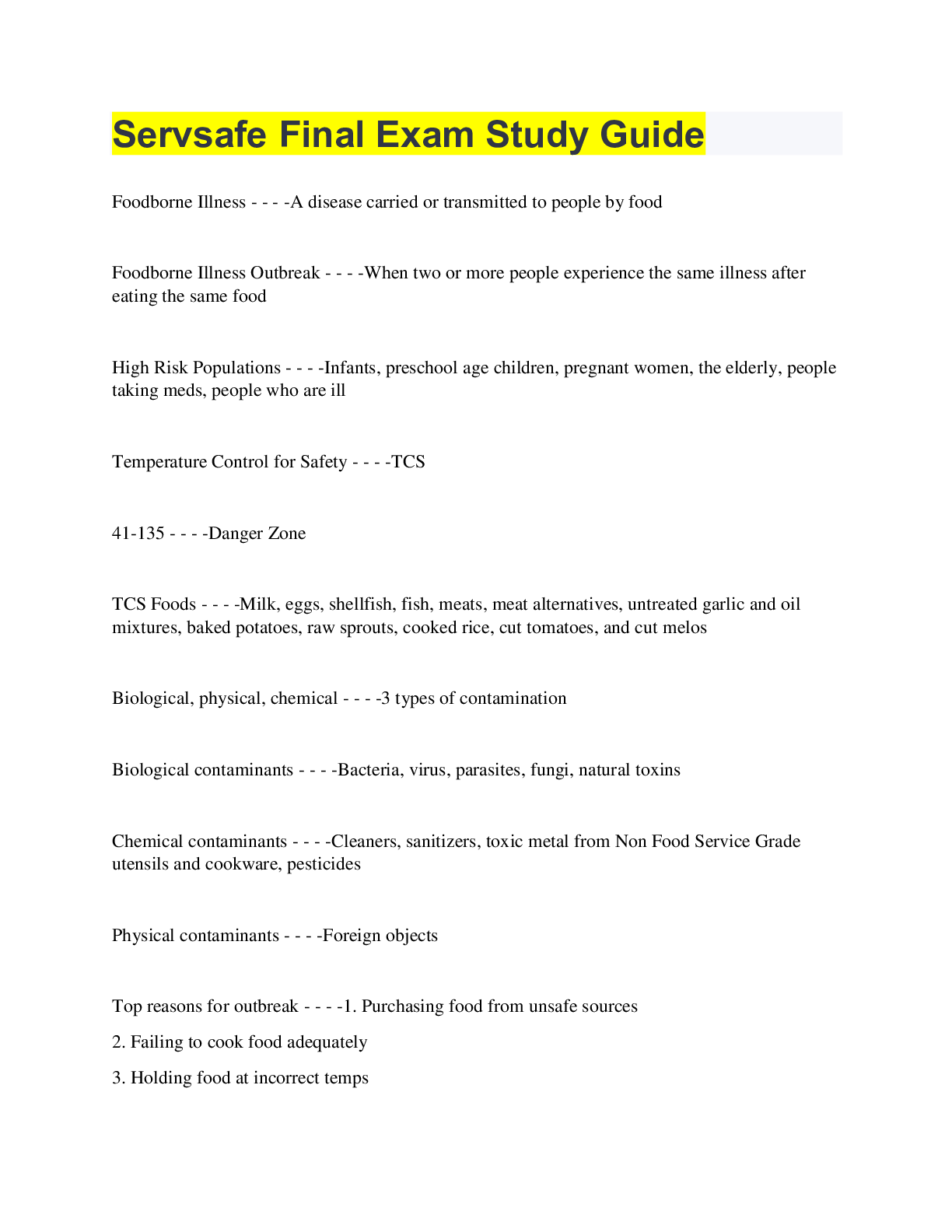
.png)

